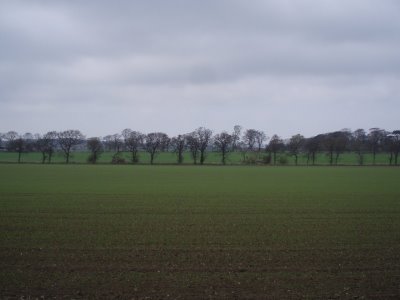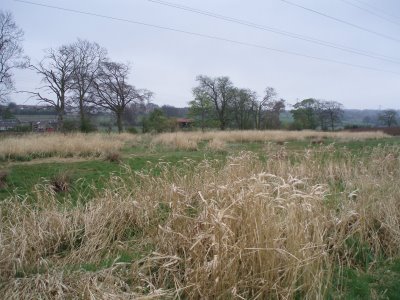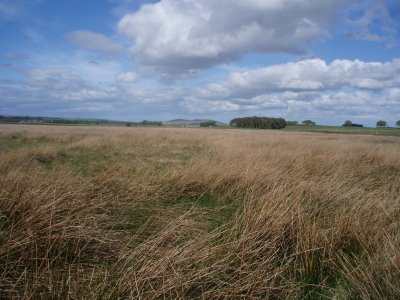Things have really been picking up in the Farm Environment office, and I have been busy working on yet more applications for the SRDP. We have quite a few clients who are going through for the next round of judging in November and the deadlines are approaching fast. I have been given one farm application to do completely on my own, for Ransfield Farm.
So far, I have done a full farm survey to look at all the current features on the farm (involving lots of tramping around, getting my trousers snagged on barbed wire and falling into wet holes), to allow me to make management suggestions. I then met with the farmer (a.k.a. Big Jim, my boyfriend’s Dad!) to discuss options such as hedge planting and management, small scale tree planting, wildflower meadows and unharvested crops.
Jim was happy with all my recommendations, so I went ahead and completed a Statement of Intent (the first stage in the SRDP application process), which includes a short summary of the work we intend to carry out, and a series of maps.
 I am now waiting to hear whether the case officer assigned to this application thinks we should go ahead or not. It is a tense time for us in the office, as we put a lot of time and effort into this first stage of the application, and it is somewhat disheartening to hear that they haven’t got through. It is particularly tense for me, I would feel pretty bad if an application I had completed didn’t get in, and also Big Jim knows where I live! I am hopeful that all our applications will make it through to the next stage, as they all involve whole farm environmental plans, and are therefore going to be favoured over applications that are seeking funding for small scale conservation efforts.
I am now waiting to hear whether the case officer assigned to this application thinks we should go ahead or not. It is a tense time for us in the office, as we put a lot of time and effort into this first stage of the application, and it is somewhat disheartening to hear that they haven’t got through. It is particularly tense for me, I would feel pretty bad if an application I had completed didn’t get in, and also Big Jim knows where I live! I am hopeful that all our applications will make it through to the next stage, as they all involve whole farm environmental plans, and are therefore going to be favoured over applications that are seeking funding for small scale conservation efforts. A boggy area at Ransfield may prove to be quite profitable if managed as a wetland under the SRDP.Alongside the office work, I have been finishing off the last of my lapwing surveys for the RSPB. Over the last few months I have been surveying four farms across the Borders, and recording the number and location of various wading birds, with the main focus of the study being on lapwings. The aim of the study is to see if farms that are carrying out agri-environment options for wading birds (such as wetland management and mown grassland for wildlife) have a greater number of wading birds. Three of the four sites were found to have lapwings, though on some sites the birds were not spotted regularly. I carried out my last visits yesterday, and was delighted to see a huge flock of 50 lapwings with young chicks (a bit unsteady on the wing, one even crash landed onto the back of a sheep!).
A boggy area at Ransfield may prove to be quite profitable if managed as a wetland under the SRDP.Alongside the office work, I have been finishing off the last of my lapwing surveys for the RSPB. Over the last few months I have been surveying four farms across the Borders, and recording the number and location of various wading birds, with the main focus of the study being on lapwings. The aim of the study is to see if farms that are carrying out agri-environment options for wading birds (such as wetland management and mown grassland for wildlife) have a greater number of wading birds. Three of the four sites were found to have lapwings, though on some sites the birds were not spotted regularly. I carried out my last visits yesterday, and was delighted to see a huge flock of 50 lapwings with young chicks (a bit unsteady on the wing, one even crash landed onto the back of a sheep!). I have also been to a Pentland Ranger Service training day where I learnt about the common butterflies in the Pentlands. We were supposed to be doing a survey for the green hairstreak butterfly in the afternoon, but the weather was abysmal, so we just visited the sites where we may expect to see the butterflies! I enjoyed the course so much that I have also enrolled in a moth and butterfly course next Tuesday, at Vogrie with the Midlothian Ranger Service.I am keen to learn as many plant and animal species as possible during the summer, as now is really the time to be getting out and about, so I will be looking for extra opportunities to brush up on my ID skills. I have been making the most of my lunchtime walks with Fiona, our admin assistant, who is a fountain of knowledge when it comes to birds. It does mean that we don’t manage to walk very far, as she is often whipping out her binoculars or camera (often both at the same time!) to peer into bushes and trees (much to the disgust of Tiggy, Fiona’s dog, who does not enjoy the interruptions to her walk and has an expression of mild irritation on her face on such occasions!).It is amazing what you start to notice when you are really looking. I know that sounds a bit stupid, but before I was an apprentice, I used to march around and I only saw walking as a way of keeping fit, now I take my time and I am often stopping to try to identify a small flower, or a butterfly or bird that I may not have noticed before. Incidentally, Rory (my dog, not my colleague) shares Tiggy’s feelings on my new found interest in things in the hedgerow and is often disgruntled that his walks take twice as long yet cover half the distance!
I have also been to a Pentland Ranger Service training day where I learnt about the common butterflies in the Pentlands. We were supposed to be doing a survey for the green hairstreak butterfly in the afternoon, but the weather was abysmal, so we just visited the sites where we may expect to see the butterflies! I enjoyed the course so much that I have also enrolled in a moth and butterfly course next Tuesday, at Vogrie with the Midlothian Ranger Service.I am keen to learn as many plant and animal species as possible during the summer, as now is really the time to be getting out and about, so I will be looking for extra opportunities to brush up on my ID skills. I have been making the most of my lunchtime walks with Fiona, our admin assistant, who is a fountain of knowledge when it comes to birds. It does mean that we don’t manage to walk very far, as she is often whipping out her binoculars or camera (often both at the same time!) to peer into bushes and trees (much to the disgust of Tiggy, Fiona’s dog, who does not enjoy the interruptions to her walk and has an expression of mild irritation on her face on such occasions!).It is amazing what you start to notice when you are really looking. I know that sounds a bit stupid, but before I was an apprentice, I used to march around and I only saw walking as a way of keeping fit, now I take my time and I am often stopping to try to identify a small flower, or a butterfly or bird that I may not have noticed before. Incidentally, Rory (my dog, not my colleague) shares Tiggy’s feelings on my new found interest in things in the hedgerow and is often disgruntled that his walks take twice as long yet cover half the distance!
